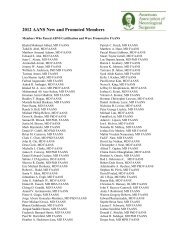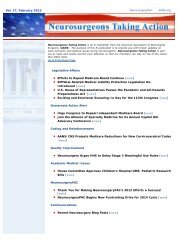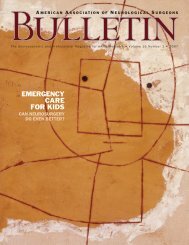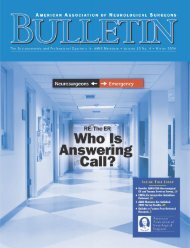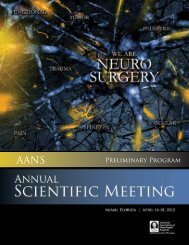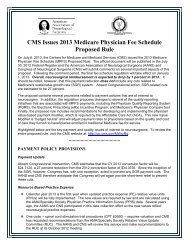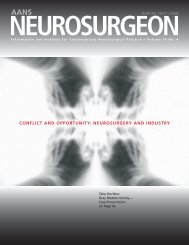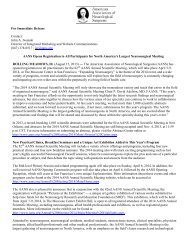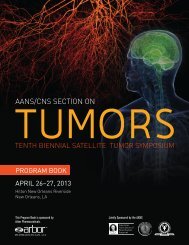view PDF - American Association of Neurological Surgeons
view PDF - American Association of Neurological Surgeons
view PDF - American Association of Neurological Surgeons
You also want an ePaper? Increase the reach of your titles
YUMPU automatically turns print PDFs into web optimized ePapers that Google loves.
R ESIDENTS’ F ORUM L AWRENCE S. C HIN, MD<br />
The Basics <strong>of</strong> Practice Management<br />
You Can Clip an Aneurysm, but Can You Compute Cost Per RVU<br />
tion for research must also be approved;<br />
one strategy is to have patients sign a consent<br />
form at initial consultation that<br />
allows their information to be used for<br />
research purposes.<br />
Knowing how to code a surgical procedure<br />
properly is important for every neurosurgeon<br />
because even when someone else<br />
handles coding, the neurosurgeon is<br />
responsible for the accuracy <strong>of</strong> submitted<br />
bills. All residents should attend a billing<br />
course such as those <strong>of</strong>fered by the AANS<br />
before starting practice. The most common<br />
Current Procedural Terminology codes,<br />
which describe the operation, and ICD-9<br />
codes, which provide the diagnosis or the<br />
symptoms, should be learned. Medicare<br />
publishes quarterly updates that detail<br />
which codes may be added on (for more<br />
reimbursement) and when “unbundling”<br />
—breaking down a procedure into smaller<br />
parts for greater reimbursement—is disallowed.<br />
An average practice <strong>of</strong> five neurosurgeons<br />
performing 1,400 cases and seeing<br />
patients in 6,000 <strong>of</strong>fice visits per year will<br />
need two coders and two collectors. At least<br />
one <strong>of</strong> the coders should be certified, a<br />
process that requires at least two years’<br />
experience and annual recertification.<br />
A medium-to-large practice will need a<br />
practice manager. A bachelor’s degree is a<br />
minimum requirement, and <strong>of</strong>ten this person<br />
will have an MBA or other master’s<br />
degree, or other appropriate credentials<br />
such as a CPA. A practice manager’s<br />
responsibilities include hiring and evaluating<br />
staff, promotions, preparing the budget<br />
and payroll, cash management, and<br />
maintaining supplies. The practice manager<br />
as well as coders and collectors should be<br />
included in a practice’s incentive program<br />
to reward them for going the extra mile.<br />
Patient satisfaction is the ultimate goal<br />
<strong>of</strong> a neurosurgical practice. An <strong>of</strong>fice management<br />
axiom is “A happy patient tells<br />
Cost per RVU (that’s relative value<br />
unit) can be determined by dividing<br />
total practice expenses by total<br />
RVUs, yielding a number that can<br />
be compared annually as an indicator <strong>of</strong> a<br />
practice’s performance. If you didn’t know<br />
that, you are not alone. Neurosurgical<br />
residency programs do a great job <strong>of</strong><br />
teaching how to diagnose and operate, but<br />
they typically do a poor job <strong>of</strong> preparing<br />
residents for the practical aspects <strong>of</strong><br />
managing a neurosurgical practice, which<br />
in reality is a small business. This article<br />
<strong>of</strong>fers some basics <strong>of</strong> practice management<br />
for the new-to-practice neurosurgeon,<br />
with focus on four primary areas: compliance,<br />
billing, <strong>of</strong>fice management, and<br />
patient relations.<br />
With the passage <strong>of</strong> the Health Insurance<br />
Portability and Accountability Act,<br />
ensuring compliance is one <strong>of</strong> the most<br />
important functions <strong>of</strong> an <strong>of</strong>fice manager.<br />
In addition to HIPAA, there are federal,<br />
state, and local regulations regarding the<br />
flow <strong>of</strong> information between patients and<br />
doctors, doctors and doctors, and doctors<br />
and the insurance carriers (including government<br />
payers). Medicare regulations<br />
generally are followed by most insurance<br />
plans, but specifics for a particular region<br />
can be found by accessing the Web site <strong>of</strong><br />
the regional Medicare intermediary. For<br />
example, Trailblazers is the intermediary<br />
responsible for handling all Medicare<br />
claims in Baltimore.<br />
The most visible aspect <strong>of</strong> HIPAA in an<br />
<strong>of</strong>fice setting relates to patient privacy. In<br />
general, relating more than one unique<br />
piece <strong>of</strong> identifying information should be<br />
avoided. For example, patients may be<br />
identified by name, but not also with their<br />
doctor’s name or diagnosis. Release <strong>of</strong><br />
patient information is allowed to referring<br />
physicians only; all others must have<br />
patient consent. Use <strong>of</strong> patient informaone<br />
person, but a dissatisfied patient tells<br />
13 people.” Find out what the patients<br />
think; send out surveys, and make sure that<br />
the practice’s phones are answered by a live<br />
person. Listen to patients’ concerns and<br />
respond to them quickly.<br />
Probably the best advice is to avoid<br />
micromanaging the practice. Let the practice<br />
manager handle the details, but know<br />
what he or she is doing because ultimately<br />
the neurosurgeon is responsible.<br />
Resources for the Real World<br />
In acknowledgement <strong>of</strong> the complex practice<br />
environment faced by today’s neurosurgical<br />
residents, resources that better<br />
prepare residents for the transition are<br />
under development. At least one training<br />
program, the Medical College <strong>of</strong> Georgia<br />
in Augusta, requires a Web-based course<br />
that acquaints its residents with basics <strong>of</strong><br />
practice management. The AANS recently<br />
<strong>of</strong>fered the course Neurosurgery in the<br />
Real World, which covered coding and<br />
reimbursement, government regulations,<br />
contract negotiations, practice development<br />
and pr<strong>of</strong>essional liability. In addition,<br />
print resources such as Starting a<br />
Medical Practice and Managing the Medical<br />
Practice are available from the AANS<br />
Online Marketplace, www.AANS.org.<br />
Perhaps the greatest resource for neurosurgeons<br />
entering practice is the AANS<br />
Young Neurosurgeons Committee. The<br />
YNC provides information at www.AANS<br />
.org > Young Neurosurgeons and develops<br />
programs like the Real World course that<br />
respond to the needs <strong>of</strong> early career neurosurgeons<br />
while opening the door to<br />
involvement in the AANS. 3<br />
Lawrence S. Chin, MD, is chair <strong>of</strong> the Department <strong>of</strong><br />
Neurosurgery at Boston University School <strong>of</strong><br />
Medicine and chair <strong>of</strong> the AANS Young<br />
Neurosurgeons Committee. Gloria Jones, <strong>of</strong>fice manager<br />
at University <strong>of</strong> Maryland Neurosurgical<br />
Associates, contributed to this article.<br />
24 Vol. 15, No. 2 • 2006 • AANS Bulletin



